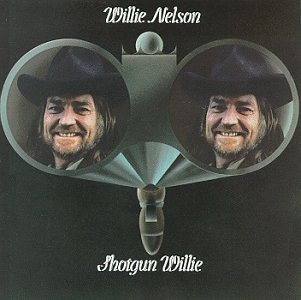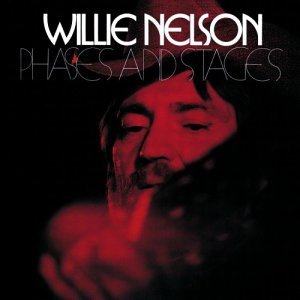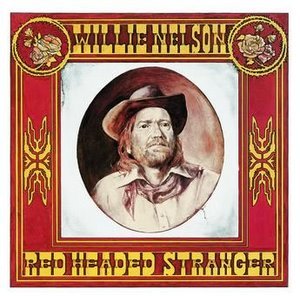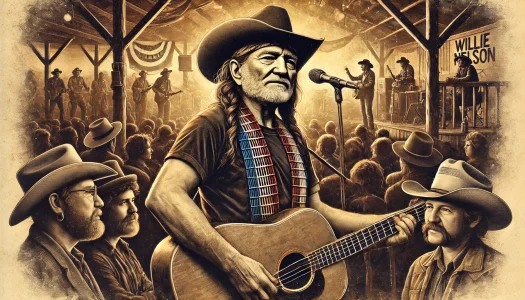The Outlaw Country movement emerged in the early 1970s as a reaction against the polished, formulaic sound that dominated Nashville’s mainstream country scene. At the time, Nashville’s music industry was tightly controlled, with producers and record labels dictating nearly every creative aspect of a song, from lyrics to instrumentation. This approach resulted in a standardized, commercially driven sound that prioritized mass appeal over artistic freedom, stifling many musicians who sought a more authentic expression.
Outlaw Country was born out of a desire to break away from these constraints and return to the raw, unfiltered roots of country music. Artists like Willie Nelson, Waylon Jennings, and Kris Kristofferson wanted greater control over their work—choosing their own musicians, crafting their lyrics, and adopting a sound that incorporated elements of rock, folk, and blues. Musically and culturally, they aimed to disrupt Nashville’s status quo, championing a rebellious spirit that resonated with audiences looking for music that felt real and unrefined.
Willie Nelson’s Early Career and Nashville Struggles
Willie Nelson’s early years in Nashville were marked by frustration with the rigid, commercial framework that defined the city’s music industry. Arriving in the early 1960s, Willie was already a skilled songwriter, penning hits like “Crazy” for Patsy Cline and “Hello Walls” for Faron Young. Despite his songwriting success, Willie struggled to establish himself as a recording artist. Nashville’s producers and record labels prioritized a clean, highly produced sound, and they often dismissed Willie’s unconventional voice and rough-around-the-edges style. This disconnect kept Willie from finding the artistic freedom he longed for.
The Nashville system was notoriously restrictive. Producers controlled nearly every aspect of a recording session, dictating everything from the choice of session musicians to the final arrangement. Willie, who thrived on spontaneity and improvisation, found himself at odds with this formulaic process. Label executives would often pressure him to conform to a polished image, even discouraging his rugged appearance and freewheeling approach. They urged him to soften his sound to fit the mainstream mold, leaving little room for the individuality and raw emotion that he wanted to bring to his music.
Frustrated by these limitations, Willie grew increasingly dissatisfied with the way Nashville valued commercial success over artistic expression. This tension ultimately drove him to step back from the industry altogether. By the early 1970s, he decided to leave Nashville in search of a place where he could play music on his own terms—a move that would ultimately lead him to Austin, Texas, and ignite the beginning of his journey as a leading figure in Outlaw Country. His Nashville struggles left a lasting impression on him, fueling his desire to create music free from industry constraints and shaping his commitment to authenticity and independence in the years to come.
The Shift to Austin and Its Impact
Willie Nelson’s move to Austin, Texas, in the early 1970s marked a critical turning point in his career, allowing him to escape the restrictions of Nashville’s music industry and find a space that embraced his unique style. Austin’s music scene was unlike anything Nashville had to offer; it was open, progressive, and eclectic, drawing artists and fans from across genres like rock, blues, folk, and country. This environment was perfectly suited to Willie’s vision—one that defied genre boundaries and celebrated creative freedom.
Austin’s venues, like the Armadillo World Headquarters, became the heart of Willie’s new musical landscape. Places like these welcomed a diverse crowd, from hippies and college students to traditional country fans, creating a rare intersection of subcultures. This eclectic audience gave Willie the freedom to experiment, blending honky-tonk, jazz, folk, and blues into his performances, without the pressure to conform to Nashville’s mainstream standards. In this atmosphere, his music could finally reflect the depth and authenticity he had always wanted, resonating deeply with listeners who craved something genuine.
The city’s laid-back, communal spirit also encouraged a more personal connection between Willie and his fans, adding to his appeal as an artist who was as approachable as he was boundary-breaking. Austin not only allowed Willie to explore and refine his sound, but it also amplified his status as a cultural icon of Outlaw Country. His success in Austin redefined what country music could be, inspiring countless artists to embrace the same kind of creative independence and authenticity that he had discovered there. This shift ultimately positioned Willie as a central figure in the Outlaw movement, cementing Austin as a home for musicians seeking artistic freedom and redefining country music for future generations.
Musical Contributions and Key Albums
Willie Nelson’s journey to Outlaw Country legend was solidified through a series of groundbreaking albums that redefined country music and embodied his rebellious spirit. Albums like Shotgun Willie (1973), Phases and Stages (1974), and Red Headed Stranger (1975) were pivotal in establishing Willie’s outlaw image and showcased his determination to push beyond Nashville’s conventions in style, storytelling, and production.
Shotgun Willie

Shotgun Willie was a defiant statement that marked the beginning of his true independence. Recorded after his move to Austin, the album broke with Nashville’s clean production standards, embracing a looser, more organic sound that combined country, rock, and blues influences. With songs like the title track “Shotgun Willie” and “Whiskey River,” Willie expressed the raw emotion and rough-hewn authenticity that would become his signature. The album was recorded with minimal overdubs and featured Willie’s close-knit circle of musicians, emphasizing spontaneity over polish. Though it was only a modest commercial success, Shotgun Willie was critically acclaimed, signaling Willie’s arrival as a creative force unafraid to break the rules.
Phases and Stages

Following Shotgun Willie, Phases and Stages took Willie’s experimental approach even further. A concept album, it told the story of a relationship’s end from both the man’s and woman’s perspectives—a rarity in country music at the time. The album was recorded in Muscle Shoals, Alabama, and featured an innovative use of lyrical themes and musical motifs to mirror the emotional journey of each character. Tracks like “Bloody Mary Morning” and “It’s Not Supposed to Be That Way” challenged country’s storytelling norms, creating a seamless narrative rather than a collection of unrelated songs. Phases and Stages showcased Willie’s ambition to craft albums with deeper narrative arcs and thematic cohesion, further setting him apart from Nashville’s commercial sound.
Red Headed Stranger

With Red Headed Stranger, Willie cemented his place as an outlaw and musical innovator. Released in 1975, the album was sparse and haunting, featuring only Willie’s understated guitar and vocals with minimal instrumentation—a stark contrast to the lush, orchestrated sound Nashville was producing. The concept album told the story of a preacher who becomes a fugitive after killing his unfaithful wife and her lover.
The storytelling was raw and unapologetic, and its stripped-down production underscored the emotional depth of the narrative. Executives at Columbia Records initially feared the album was too unconventional to sell, but Red Headed Stranger went on to become one of Willie’s most successful releases, with hits like “Blue Eyes Crying in the Rain.” Its success proved that audiences were hungry for authentic, unfiltered music that didn’t fit Nashville’s mold.
Willie’s Collaborations with Other Outlaw Artists
Willie Nelson’s role in Outlaw Country was amplified through powerful collaborations with other key figures in the movement, including Waylon Jennings, Johnny Cash, and Kris Kristofferson. These partnerships were more than just musical collaborations—they were alliances rooted in a shared desire to challenge Nashville’s mainstream country norms. Together, these artists redefined what country music could be, building a sound and identity that resonated with fans who craved authenticity.
Wanted! The Outlaws
A landmark of Willie’s collaborative efforts was Wanted! The Outlaws, released in 1976. Featuring tracks by Willie, Waylon Jennings, Jessi Colter, and Tompall Glaser, this compilation was the first country album to be certified platinum. It was a watershed moment that brought Outlaw Country into the mainstream, proving that there was a major audience for the raw, rebellious style these artists championed. The album’s success was unexpected; Columbia Records initially saw it as a low-risk release, but it quickly became a runaway hit, with standout tracks like Willie’s “Me and Paul” and Waylon’s “Honky Tonk Heroes” capturing the freewheeling, independent spirit of the Outlaw movement.
The success of Wanted! The Outlaws showed that Outlaw Country wasn’t just a niche genre—it was a cultural force. Willie and his collaborators became icons of independence, pushing boundaries both musically and culturally. Their camaraderie went beyond recording sessions, with these artists often sharing the stage and supporting one another’s creative pursuits. Willie and Waylon, in particular, had a close partnership, blending their distinct voices and styles to create a unique sound that balanced Willie’s laid-back approach with Waylon’s gritty, rock-influenced edge. Their duet “Good Hearted Woman” became one of the movement’s defining songs, celebrating the outlaw lifestyle with humor and sincerity.
The Highwaymen, a supergroup Willie later formed with Jennings, Kristofferson, and Cash, further solidified his legacy. The group allowed each artist to explore themes of resilience, freedom, and life’s struggles, connecting deeply with audiences around the world. Through these collaborations, Willie helped turn Outlaw Country into a genre that transcended its own movement, leaving an enduring impact on country music and inspiring future artists to embrace artistic freedom and authenticity.
Cultural Influence and Icon Status
Willie Nelson’s influence on Outlaw Country went beyond his music—his image and lifestyle became as much a part of the movement’s identity as the sound itself. In a genre dominated by clean-cut stars and polished personas, Willie’s look and lifestyle were strikingly unconventional. With his long hair, signature bandana, and casual, rugged attire, Willie rejected the groomed appearance that Nashville traditionally expected of its artists. His image as a renegade resonated with fans who were drawn not only to his music but to the authenticity and freedom he represented.
Willie’s embrace of personal freedom was evident in both his music and his life. He openly rejected the expectations of the country music establishment, creating a style that reflected his individuality and independence. Offstage, his commitment to living on his own terms—whether advocating for marijuana legalization, championing environmental causes, or supporting American farmers—helped establish him as a cultural figure who stood for something beyond music. This ethos of living freely and authentically became core to the Outlaw Country philosophy, and fans saw Willie as a symbol of defiance against societal constraints, embodying a spirit that was rebellious yet relatable.
The aesthetic Willie helped create was soon emulated by other artists, shaping the Outlaw Country look and attitude. His casual, bohemian style contrasted sharply with Nashville’s formal dress codes, and his untamed image gave fans a new vision of what a country artist could be. It wasn’t just about rejecting Nashville’s standards—it was about embodying the independence and unvarnished truth that the Outlaw movement celebrated. This unique style, along with his willingness to speak his mind and challenge norms, turned Willie into a larger-than-life figure, respected across generations and musical genres.
